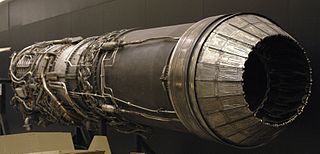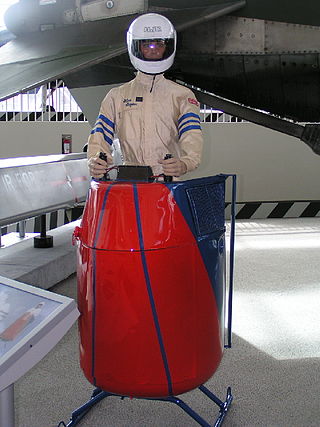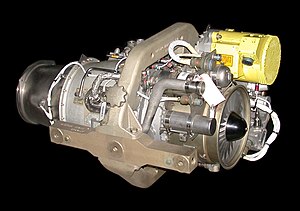
The General Electric F110 is an afterburning turbofan jet engine produced by GE Aerospace. It was derived from the General Electric F101 as an alternative engine to the Pratt & Whitney F100 for powering tactical fighter aircraft, with the F-16C Fighting Falcon and F-14A+/B Tomcat being the initial platforms; the F110 would eventually power new F-15 Eagle variants as well. The engine is also built by IHI Corporation in Japan, TUSAŞ Engine Industries (TEI) in Turkey, and Samsung Techwin in South Korea as part of licensing agreements.

The Pratt & Whitney F119, company designation PW5000, is an afterburning turbofan engine developed by Pratt & Whitney for the Advanced Tactical Fighter (ATF) program, which resulted in the Lockheed Martin F-22 Raptor. The engine delivers thrust in the 35,000 lbf (156 kN) class and was designed for sustained supersonic flight without afterburners, or supercruise. Delivering almost 22% more thrust with 40% fewer parts than its F100 predecessor, the F119 allows the F-22 to achieve supercruise speeds of up to Mach 1.8. The F119's nozzles incorporate thrust vectoring that enable them to direct the engine thrust ±20° in the pitch axis to give the F-22 enhanced maneuverability.

The Pratt & Whitney F100 is a low bypass afterburning turbofan engine. It was designed and manufactured by Pratt & Whitney to power the U.S. Air Force's "FX" initiative in 1965, which became the F-15 Eagle. The engine was to be developed in tandem with the F401 which shares a similar core but with an upscaled fan for the U.S. Navy's F-14 Tomcat. The F401 was later abandoned due to costs and reliability issues. The F100 also powered the F-16 Fighting Falcon for the Air Force's Lightweight Fighter (LWF) program.

The Pratt & Whitney J57 is an axial-flow turbojet engine developed by Pratt & Whitney in the early 1950s. The J57 was the first 10,000 lbf (45 kN) thrust class engine in the United States. It is a two spool engine.

The General Electric J79 is an axial-flow turbojet engine built for use in a variety of fighter and bomber aircraft and a supersonic cruise missile. The J79 was produced by General Electric Aircraft Engines in the United States, and under license by several other companies worldwide. Among its major uses was the Lockheed F-104 Starfighter, Convair B-58 Hustler, McDonnell Douglas F-4 Phantom II, North American A-5 Vigilante and IAI Kfir.

The Williams X-Jet, created by Williams International, was a small, single-person, light-weight, Vertical Take Off and Landing (VTOL) aircraft powered by a modified Williams F107 turbofan aircraft engine — designated WR-19-7 — after some minor modifications. The vehicle was nicknamed "The Flying Pulpit" for its shape. It was designed to carry one operator and to be controlled by leaning in the direction of desired travel and by modulating engine output power. It could move in any direction, accelerate rapidly, hover and rotate on its axis, stay aloft for up to 45 minutes and travel at speeds up to 60 miles per hour (97 km/h). It was evaluated by the United States Army in the 1980s, but was deemed inferior to the capabilities of helicopters and small, uncrewed aircraft, and so the development of the X-Jet was discontinued.

The Williams F107 is a small turbofan engine made by Williams International. The F107 was designed to propel cruise missiles. It has been used as the powerplant for the AGM-86 ALCM, and BGM-109 Tomahawk, as well as the experimental Kaman KSA-100 SAVER and Williams X-Jet flying platform.

The Pratt & Whitney J52 is an axial-flow dual-spool turbojet engine originally designed for the United States Navy, in the 40 kN class. It powered the A-6 Intruder and the AGM-28 Hound Dog cruise missile. As of 2021 the engine was still in use in models of the A-4 Skyhawk.
The Williams EJ22 was a small turbofan engine that was being developed by Williams International for very light jet (VLJ) aircraft applications.

The General Electric CJ805 is a jet engine which was developed by General Electric Aircraft Engines in the late 1950s. It was a civilian version of the J79 and differed only in detail. It was developed in two versions. The basic CJ805-3 was a turbojet and powered the Convair 880 airliner, and the CJ805-23 a turbofan derivative which powered the Convair 990 Coronado variant of the 880.

The General Electric YF120, internally designated as GE37, was a variable cycle afterburning turbofan engine designed by General Electric Aircraft Engines in the late 1980s and early 1990s for the United States Air Force's Advanced Tactical Fighter (ATF) program. It was designed to produce maximum thrust in the 35,000 lbf (156 kN) class. Prototype engines were installed in the two competing technology demonstrator aircraft, the Lockheed YF-22 and Northrop YF-23.

The Williams FJ33 is an American family of turbofan jet engines intended for use in very light jet aircraft. The FJ33 is a scaled-down version of the FJ44 engine. The FJ33-5A is the latest version certified in June 2016.

The Soloviev D-20P, built by the Soloviev Design Bureau, was a low-bypass turbofan engine rated at 52.9 kN (11,900 lbf) thrust used on the Tupolev Tu-124. Elements of the design were used in the development of the larger Soloviev D-30 family of low and medium bypass engines.

The General Electric CF700 is an aft-fan turbofan development of the CJ610 turbojet. The fan blades are an extension of the low-pressure turbine blades.

The Williams F121 is a small turbofan engine designed for use in the AGM-136 Tacit Rainbow anti-radiation cruise missile.
The Teledyne CAE F106 was a small American turbofan engine developed to power cruise missiles.
The Microturbo TRI-40 is a small turbojet engine developed for use in cruise missiles and small unmanned aerial vehicles in the 2.2 - 3.6 kN thrust class.

The Microturbo TRI 60 is a small, expendable turbojet engine developed for use in cruise missiles, target drones, and other small unmanned air vehicles. Variants of this engine produce from 3.5 to 5.3 kN of thrust. The engine first ran in 1974.

The Teledyne CAE J402 is an American small turbojet engine. Several variants have been developed to power unmanned air vehicles such as missiles and target drones. Developed in the 1970s for the Harpoon anti-ship missile, the J402 was the first jet engine to be designed as a "wooden round", meaning that the engine had to be able to sit for long periods without maintenance or inspection and work right away.

The Ivchenko Progress D-36 is a three-shaft high bypass ratio turbofan currently produced by the Ukrainian Motor Sich company.

















